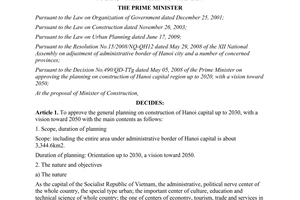Nội dung toàn văn Decision No. 673/QĐ-UBND 2014 development of vocational colleges secondary schools training centers in Hanoi
|
THE PEOPLE’S COMMITTEE OF HANOI |
SOCIALIST REPUBLIC OF VIET NAM
|
|
No: 673/QĐ-UBND |
Hanoi, January 24, 2014 |
DECISION
APPROVAL FOR THE PLAN FOR DEVELOPMENT OF VOCATIONAL COLLEGES, VOCATIONAL SECONDARY SCHOOLS AND VOCATIONAL TRAINING CENTERS IN HANOI BY 2020, THE ORIENTATION TOWARDS 2030
THE PEOPLE’S COMMITTEE OF HANOI
Pursuant to Law on Organization of the People’s Councils and the People’s Committees of provinces dated March 26, 2003
Pursuant to Decree No. 92/2006/NĐ-CP dated September 07, 2006 of the Government prescribing the formulation, approval and management of the master plan for social-economic development; Decree No. 04/2008/NĐ-CP dated January 11, 2008 of the Government prescribing the amendments to some articles of Decree No. 92/2006/NĐ-CP; Circular No. 05/TT-BKHĐT dated October 31, 2013 of Ministry of Planning and Investment giving instructions on formulation, inspection, approval, amendments and announcement of the master plan for social-economic development and the plan for the development of primary industries and products.
Pursuant to Decision No. 1081/QĐ-TTg dated July 06, 2011 of the Prime Minister on the approval for the master Plan for social-economic development in Hanoi by 2020, the orientation towards 2030; Decision No. 1259/QĐ-TTg dated July 26, 2011 of the Prime Minister on the approval for the overall plan for the development of Hanoi by 2030, the orientation towards 2050;
Pursuant to Resolution No. 23/2013/NQ-HĐND dated December 04, 2013 of The 15th People’s Council of Hanoi session 8 on the approval of the plan for the development of vocational colleges, vocational secondary schools and vocational training centers by 2020, the orientation towards 2030.
Pursuant to the Report No. 2977/TTr-SLĐTBXH dated December 27, 2013 of Department of Labor, Invalids and Social Affairs of the province on the approval of the plan for the development of vocational colleges, vocational secondary schools and vocational training centers by 2020, the orientation towards 2030;
At the request of Department of Planning and Investment of the province in the Report No. 1365/BC-KHĐT dated December 12, 2013,
DECISION
Article 1: The plan for the development of vocational colleges, vocational secondary schools, vocational training centers in Hanoi (hereinafter referred to as vocational schools) by 2020, the orientation towards 2030 which has been approved, includes:
1. Viewpoints:
The plan for vocational school system shall be developed in terms of the plan for the social-economic development, the overall plan for the development of Hanoi, the plan for the industries, associated with local and nationwide development in order to provide high quality workers for cities and provinces in the Red River Delta and in the whole country.
The vocational school system shall be developed in terms of the cooperation, operation of vocational centers under the management of Ministries and central agencies; ensuring a systematic and continuous development to satisfy the need for socio-economic development of Hanoi.
The involvement of private sector shall be enhanced to develop vocational school system.
Quality and scale of the vocational training shall be developed to satisfy the demands of domestic industries in favor of high quality employees and labor export.
2. Aims
2.1 General aim
Ensuring comprehensive development and rational structure of the system of vocational schools in Hanoi so that the manpower supplies are adequate to meet the demands in terms of quality, quantity and proportions of the vocations, the training quality of some careers reachs the ASEAN or international standards; providing skilled workers, enhancing their competitiveness, providing the employees with fundamental vocational training, which contributes to employment structuring, income increase, poverty reduction and guarantee for provision of social welfare
2.2 Specific aims
- With regard to trained workers:
By 2050, the rate of trained workers is expected to exceed 40% (among which those at the fundamental level at least make up more than 28%); By 2020, the rate of trained workers is expected exceed 55% (among which those at the fundamental level at least make up more than 28%); By 2030 the rate of trained workers is expected to be approximate 90%
- With regard to the vocational school system:
The vocational schools shall be invested in and upgraded to reach the national standards in terms of facilities and equipment. The goal is each district has at least one vocational school. Private vocational schools are developed. Some vocational colleges or secondary schools will be upgraded to exemplary vocational centers or to reach the international, ASEAN or local standards. The vocational schools cooperate with trade villages and enterprises in training. By 2015, there will be 14 vocational colleges (one of which is of international standards, another one is a high quality college), 32 vocational secondary schools, 57 vocational training centers (one of which is an exemplary center). By 2020, there will be 21 vocational colleges (two of which are of international standards, three are of ASEAN standards, one is high quality school, three are of local standards), 32 vocational secondary schools (one to three of which are of local standards), 66 vocational training centers (one of which is an exemplary center)
By 2030, there are about 23 vocational colleges, 34 vocational secondary schools and 73 vocational training centers.
- With regard to the teachers:
By 2020, the expertise, teaching skills and professional skills of vocational teachers must meet standards and suit the proportions of the vocations being trained; 30% of teachers in vocational colleges and vocational secondary schools possess postgraduate degrees. This rate should reach 50% by 2030.
3. Plan for the development of vocational schools by 2020, the orientation towards 2030
3.1. With regard to the vocational school system:
a) By 2015: The effective vocational schools shall be maintained; the ineffective ones shall be dealt with; vocational schools shall be invested, upgraded and extended to suit their scale and quality, in particular:
- There are 14 vocational colleges, including:
+ 4 public vocational colleges among which Hanoi high-tech vocational college will be upgraded to an internationally-recognized college, Hanoi vocational college of Industry will be upgraded to a high quality college; the vocational college of business and technology (affiliated to the State-owned enterprises) will be maintained and upgraded; Vietnam- Korea vocational college will be established.
+ There are 10 private vocational colleges among which 08 colleges have been already established, 2 colleges that provide training in cuisine, hospitality, bodyguard services, information technology and labor export shall be established in Soc Son and Hoang Mai
- There are 32 vocational secondary schools, including:
+ 07 public vocational secondary schools maintained and upgraded, one of which is affiliate to the State-owned enterprises.
+ 25 private vocational secondary schools
- There are 57 vocational training centers, including:
+ 16 public vocational centers among which Ba Vì vocational center will be upgraded to an exemplary center, 15 centers under the management of such organizations, associations and local authorities will be upgraded.
+ 41 private vocational centers among which 38 centers have already been established, 03 centers for social services (such as nursing, home care, beauty makeup, beauty care, skin care, hair care, information technology, fashion, furniture manufacture, handicraft..) will be established in Phúc Thọ, Mỹ Đức và Sơn Tây.
b) By 2020: the vocational schools shall be invested, upgraded and extended to suit the training scale; some vocational secondary schools shall be upgraded to vocational colleges; some vocational colleges and centers shall be established.
- There are 21 vocational colleges, including:
+ 06 vocational colleges among which 04 colleges have been already established, 02 vocational colleges are upgraded from vocational secondary schools (Hanoi vocational secondary school 1 is upgraded to Phu Xuyen high quality vocational college; Hanoi vocational secondary school that provide training in cuisine and hospitality is upgraded to Hanoi vocational college of Tourism and Hospitality), Hanoi high-tech vocational college is of international standards, Hanoi industrial vocational college and Hanoi vocational college of Tourism and Hospitality are of ASEAN standards; Phu Xuyen vocational college is a high quality college. Some colleges are eligible to provide vocational education services in Thạch Thất, Sóc Sơn, Phú Xuyên.
+ 15 private vocational colleges among which Tran Hung Dao vocational college is upgraded to an internationally-recognized college, Thang Long vocational college is of ASEAN standards; 05 vocational colleges will be established in Chuong My, Phu Xuyen, Quoc Oai, My Duc and Son Tay.
- There are 32 vocational secondary schools, including:
+ 07 vocational secondary schools, one of which is affiliated to the State-owned enterprises. Vocational center of the Hanoi Association for the blind is upgraded to Vocational secondary school for the handicapped. Ung Hoa vocational center is upgraded to Ung Hoa vocational secondary school. Hanoi vocational secondary school of Cuisine and Hospitality is upgraded to the Hanoi vocational college of Tourism and Hospitality. Hanoi vocational secondary school 1 is upgraded to Phu Xuyen high quality vocational college.
+ 25 private vocational secondary schools
- There are 66 vocational training centers, including:
+ 18 public vocational training centers among which 14 centers are maintained and upgraded, 02 centers are excluded due to their upgradation to vocational secondary schools (Ung Hoa vocational center and vocational center of the Hanoi Association for the blind); 04 vocational centers shall be established in Ba Vì, Quốc Oai, Phúc Thọ, and Mỹ Đức. The vocational centers in Ba Vi and Thanh Tri are being upgraded to exemplary centers.
+ 48 private vocational training centers of which 41 centers are operating, 07 centers will be established in Đan Phượng, Phú Xuyên, Chương Mỹ, Long Biên, Mê Linh, Đông Anh, Sóc Sơn.
c) By 2030:
- There are 23 vocational colleges including:
+ 06 public vocational colleges
+ 17 private vocational colleges among which 15 colleges are already established, 02 colleges will be established in Sóc Sơn, Ứng Hòa.
- There are 34 vocational secondary schools including:
+ 07 public schools, one of which is affiliated to the State-owned enterprises.
+ 27 private vocational secondary schools among which 25 schools have already been established and 02 schools will be established.
- There are 73 vocational centers including:
+ 18 public vocational centers
+ 55 private vocational training centers among which 48 centers have already been established and 07 centers will be established.
- Schools of international standards, high quality schools, schools of ASEAN standards, schools of local standards and exemplary centers are maintained.
3.2 Proportions of vocations and training level
Vocational training scale and quality shall be developed in terms of 3 levels: college level, intermediate level, and beginning level. Training quality and result shall be focused on to ensure comprehensive development of the proportions of training vocations and vocational levels. The quality of the workers shall be enhanced to satisfy the demand of the social-economic development.
Special training shall be provided for the workers in the field of industry and services to satisfy the demand of the industrialization and modernization. The training scale of some occupational groups attracting a large number of learners shall be enlarged such as: Industrial electricity, civil electrical engineering, industrial electronics, automotive technology, metalworking, computer programming, computer network administration, power tool repair, mechanical assembly, air conditioner technology, computer-aided design, database administration, electric system, computer assembly and repair.
Training in traditional vocations shall be developed in trade villages.
Vocational training shall be provided for enterprises, production, business and service establishments.
3.3 Facilities:
- The facilities provided to the vocational schools must be standardized, modern and synchronized; specialized sections and constructions items must be adequate for teaching, learning and overall education.
- By 2020: the land, facilities, workshops, classrooms, dormitories and sports areas of all of the vocational schools must meet the required standards.
3.4. Vocational teachers
The vocational teachers must be adequate to meet the demands in terms of quantity, moral qualities, and professional ethnics. The theoretical and practical expertise, teaching skills and professional skills of them must meet standards. They are also required to have computer and foreign language skills to apply to teaching and scientific research. The ratio of teachers to learners is 1:20. By 2020, 30% of the teachers in vocational colleges and vocational secondary schools possess postgraduate degrees, 50% of vocational teachers can apply information technology to teaching. By 2030, 50% of the vocational teachers possess postgraduate degrees and all of the teachers can apply information technology to teaching.
3.5. Vocational programmes and course books:
The programmes and textbooks shall be innovated according to vocational skill standards in order to suit the technological development of production and keep up with the advanced level, ensure training continuity by vocation analysis, integration of knowledge and skills.
By 2020: the programmes and course books of any vocational school must be modern and suitable for each vocation or vocation group being trained.
4. Solutions for implementation of the plan:
a) Enhancing the administration, instructing the organizations, associations and society in vocational training activities.
The conformity of the policies of the Communist Party, the law of the Government on the development of manpower, vocational teaching and learning shall be enhanced; training shall be preferably invested in, vocational training is considered as a significant breakthrough in the plan for the social-economic development, solutions to the unemployment, guarantee for provision of social welfare
b) Enhancing the Government’s management of the vocational teaching
Vocational schools and their training programmes shall be inspected. Vocational schools are responsible for their teaching quality, enrolments, graduation and self-inspections. They shall be periodically evaluated by the agencies in charge of inspecting vocational teaching quality.
c) Introducing policies to develop the vocational training network
The policies shall be established to support the enterprises to establish vocational schools; vocational schools shall cooperate with each other to provide training and jobs. Model, form and methods shall be developed to enhance the cooperation between the enterprises and the vocational schools to provide the learners with jobs after they complete their training.
d) Enhancing international cooperation in vocational training
The international cooperation shall be enhanced to exchange and gain experience from other countries, especially countries that have succeeded in vocational training. The cooperation with vocational schools in developed countries shall be encouraged to exchange training programmes, teachers, experts, technology and teaching methods.
e) Solution for capital
The total estimated expense used for the development of vocational schools in Hanoi by 2030 is about 31.320 billion VND. The capital shall be dealt with as follows:
The proportion of investment in vocational training shall be raised to over 13% of the total budget for education and training. Major vocational training schools, disadvantaged areas, suburban areas shall be invested; the programme shall be developed; vocational training shall be provided for rural workers, beneficiaries of incentive policies, and disadvantaged groups in society and fundamental vocational training shall be provided for workers.
The involvement of the private sector and resources for the development of vocational training including those of the government, enterprises, learners, domestic and foreign investors of which the State budget is specially important shall be encouraged.
Policies to secure capital funding from the domestic private investors shall be established to enable the vocational schools to receive benefits of credit and investment incentives and to buy equipment for vocational training without import tax.
Policies shall be introduced to encourage the vocational schools to raise non-public capital for their development.
The State and ODA capital shall be used for the investment in major schools and job placement centers to develop training model.
The financial independence shall be encouraged, which is not only a motivation for the development of the vocational schools but also a criterion for performance evaluation
Article 2: Implementation
The plan for development of the vocational schools in Hanoi by 2020, the orientation towards 2030 is a basis for the five-year or annual plans, the orientation of the development of the vocational schools in Hanoi. The People’s Committee of Hanoi has assigned:
1. The Department of Labor, Invalids and Social Affairs of Hanoi to:
- Announce, disseminate the plan; formulate an implementation plan.
- Take charge and cooperate with the local authorities in Hanoi in implementing 5-year and annual plans, programmes and projects on the development.
- Advise the People’s Committee of Hanoi adjusting the plan whenever it is found inappropriate.
2. Local authorities in Hanoi to:
Cooperate with the Department of Labor, Invalids and Social Affairs of Hanoi in implementing the plan.
3. The People’s Committees of districts to:
Integrate the plan for the development of vocational schools with the master plan for the social-economy development of such districts; establish and implement the programmes, plans and projects on the development of such districts.
The Chief of the People's Committee of Hanoi Secretariat, Director of the departments of the City; Chairmen of the People's Committees of districts; Heads of relevant agencies and units shall implement this Decision. /.
|
|
ON BEHALF OF THE PEOPLE’S COMMITTEE OF THE
PROVINCE |
APPENDIX
LIST OF THE PROJECTS FOR THE DEVELOPMENT OF VOCATIONAL COLLEGES,
VOCATION SECONDARY SCHOOLS AND VOCATIONAL TRAINING CENTERS BY 2020, THE
ORIENTATION TOWARDS 2030
( Attached to Decision No. 673/QĐ-UBND dated
January 24, 2014 of the People’s Committee of Hanoi)
|
No |
Project name |
Location |
Notes |
|
|
From 2013 to 2015 |
|
|
|
1 |
Hung Vuong vocational training center |
Cau Giay District |
Licensed |
|
2 |
Van Son humanity vocational training center |
Soc Son District |
Licensed |
|
3 |
Ha An driving school |
Soc Son District |
Licensed |
|
4 |
Vocational training center for bodyguard services |
Hoang Mai District |
Licensed |
|
5 |
Office building and vocational training center for labor export |
Cau Giay District |
Licensed |
|
6 |
Van Canh vocational secondary school |
Hoai Duc District |
Licensed |
|
7 |
Tay An vocational technical secondary school |
Dan Phuong District |
Licensed |
|
8 |
Sao Bac Viet vocational training center |
Ha Dong District |
Licensed |
|
9 |
Vocational Secondary School of Technology |
Thuong Tin District |
Licensed |
|
10 |
Thang Long private secondary school of technology |
Hoai Duc District |
Licensed |
|
11 |
Thien Duc vocational secondary school |
Soc Son District |
Licensed |
|
12 |
Hanoi vocational secondary school of Information and Media |
Gia Lam District |
Licensed |
|
13 |
Vocational center for carpentry and embroidery |
Cau Giay District |
Licensed |
|
14 |
Tran Hung Dao vocational college |
Dong Anh District |
Licensed |
|
15 |
Dai Cuong vocational training center |
Long Bien District |
Licensed |
|
16 |
Gaet vocational training center |
Tu Liem District |
Licensed |
|
17 |
Cuu Long vocational training center |
Tu Liem District |
Licensed |
|
18 |
Vocational and Continuing education center in Me Tri ward |
Tu Liem District |
Licensed |
|
19 |
Phu Chau vocational college |
Hoang Mai District |
Licensed |
|
20 |
Vocational training center |
Tu Liem District |
Licensed |
|
21 |
High quality vocational training center |
Dong Anh District |
Licensed |
|
22 |
Driving school affiliated to Thanh Xuan private vocational training center |
Dong Anh District |
Licensed |
|
23 |
Thang Long vocational training center |
Tu Liem District |
Licensed |
|
24 |
Office building, vocational school and business establishment |
Thanh Tri District |
Licensed |
|
25 |
Minh Tam private humanitarian vocational training center |
Thach That District |
Licensed |
|
26 |
Vietnam- Korea vocational college |
Dong Anh District |
Licensed |
|
27 |
Vocational college in Soc Son |
Soc Son District |
|
|
28 |
Vocational college in Hoang Mai |
Hoang Mai District |
|
|
29 |
Phuc Tho vocational training center |
Phuc Tho District |
|
|
30 |
My Duc vocational training center |
My Duc District |
|
|
31 |
Son Tay vocational training center |
Son Tay District |
|
|
32 |
Chuong My Vocational college |
Chuong My District |
|
|
|
From 2016 to 2020 |
|
|
|
33 |
Phu Xuyen High quality Vocational college |
Phu Xuyen District |
|
|
34 |
Hanoi vocational college of tourism and hospitality |
Son Tay District |
|
|
35 |
Vocation college 17 |
Thanh Xuan District |
|
|
36 |
Vocation college 10 |
Thanh Xuan District |
|
|
37 |
Quoc Oai vocational training center |
Quoc Oai District |
|
|
38 |
My Duc vocational training center |
My Duc District |
|
|
39 |
Phuc Tho vocational training center |
Phuc Tho District |
|
|
40 |
Ba Vi vocational training center |
Ba Vi District |
|
|
41 |
Son Tay vocational college |
Son Tay District |
|
|
42 |
Phu Xuyen high-tech vocational college |
Phu Xuyen District |
|
|
43 |
Quoc Oai vocational college |
Quoc Oai District |
|
|
44 |
My Duc vocational college |
My Duc District |
|
|
45 |
Vocational secondary school for the handicapped |
Ha Dong District |
|
|
46 |
Ung Hoa Vocational secondary school |
Ung Hoa District |
|
|
47 |
Dan Phuong vocational training center |
Dan Phuong District |
|
|
48 |
Phu Xuyen vocational center |
Phu Xuyen District |
|
|
49 |
Chuong My vocational training center |
Chuong My District |
|
|
50 |
Long Bien vocational training center |
Long Bien District |
|
|
51 |
Me Linh vocational training center |
Me Linh District |
|
|
52 |
Dong Anh vocational training center |
Dong Anh District |
|
|
53 |
Soc Son vocational training center |
Soc Son District |
|
Note: The location, scale, land areas, total invested capital and invested capital resources of above projects shall be specifically calculated during the formulation and appraisal of such projects.
------------------------------------------------------------------------------------------------------
This translation is made by LawSoft and
for reference purposes only. Its copyright is owned by LawSoft
and protected under Clause 2, Article 14 of the Law on Intellectual Property.Your comments are always welcomed



